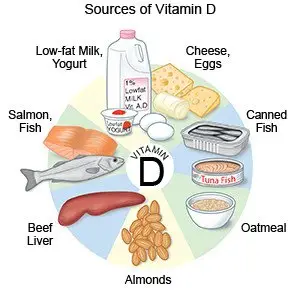What is vitamin D deficiency?
Vitamin D deficiency is a low level of vitamin D in your body. Vitamin D helps your body absorb calcium from foods.
Vitamin D is also essential for maintaining a healthy immune system. The function of the immune system is to prevent or limit infection.
Your body makes vitamin D when your skin is exposed to sunlight. You can also get vitamin D from certain foods. Most of the vitamin D in your body comes from sunlight exposure.
What increases my risk for vitamin D deficiency?
- Low amount of sun exposure
- Low intake of foods that contain vitamin D
- Having dark skin
- Age older than 65
- Pregnancy or breastfeeding
- Infants who are breastfed
- Inability to absorb vitamin D from food
- Obesity
- Use of certain medicines such as antiseizure, steroid, or antifungal medicines
What are the signs and symptoms of vitamin D deficiency?
Low levels of vitamin D can lead to weak and brittle bones that are more likely to fracture. You may not have any signs and symptoms, or you may have any of the following:
- Bone pain or discomfort in your lower back, pelvis, or legs
- Muscle aches and weakness
- Low back pain in women
- Poor growth, irritability, and frequent respiratory tract infections in infants
- Deformed bones and slow growth in children
How is vitamin D deficiency diagnosed and treated?
Blood tests will be done to measure the amount of vitamin D in your blood. Your healthcare provider may give you high doses of vitamin D for 8 to 12 weeks to increase your levels. Your levels will then be rechecked. If your levels are still low, you will need to take vitamin D supplements for another 8 weeks. After your levels have gone back to normal, you may need to continue to take a vitamin D supplement.
How much vitamin D do I need each day?
The amount of vitamin D you need depends on your age. You may need more than the recommended amounts below if you take certain medicines or you are obese. Ask your healthcare provider how much vitamin D you need.
- Infants up to 1 year of age: 400 international units (IU)
- Children 1 year and older: 600 IU
- Adults aged 19 to 70 years old: 600 IU
- Adults older than 70 years: 800 IU
Treatment options
The following list of medications are in some way related to or used in the treatment of this condition.
- Vitamin D3
- D3
- Replesta
- Drisdol
- Calciferol
View more treatment options
How can I help prevent vitamin D deficiency?
- Eat foods that are high in vitamin D. Fatty fish such as mackerel, canned tuna and sardines, and salmon are good sources of vitamin D. Eggs, almonds, and meat such as liver are also good sources. Certain foods such as milk, juice, and cereal are fortified with vitamin D.

- Give your breastfed infant a vitamin D supplement of 400 IU each day.
- Take vitamin D supplements as directed. High doses of vitamin D can be toxic. Your healthcare provider will tell you how much vitamin D you should take each day. Vitamin D is best absorbed when taken with food.
- Expose your skin to sunlight as directed. Ask your healthcare provider how you can safely expose your skin to sunlight and for how long. Too much exposure to sunlight can cause skin cancer.
When should I call my doctor?
- You continue to have symptoms, or your symptoms get worse.
- You think you took too much of a vitamin D supplement, and you have nausea, vomiting, or a headache.
- You have questions or concerns about your condition or care.
Care Agreement
You have the right to help plan your care. Learn about your health condition and how it may be treated. Discuss treatment options with your healthcare providers to decide what care you want to receive. You always have the right to refuse treatment. The above information is an educational aid only. It is not intended as medical advice for individual conditions or treatments. Talk to your doctor, nurse or pharmacist before following any medical regimen to see if it is safe and effective for you.© Copyright Merative 2023 Information is for End User's use only and may not be sold, redistributed or otherwise used for commercial purposes.




